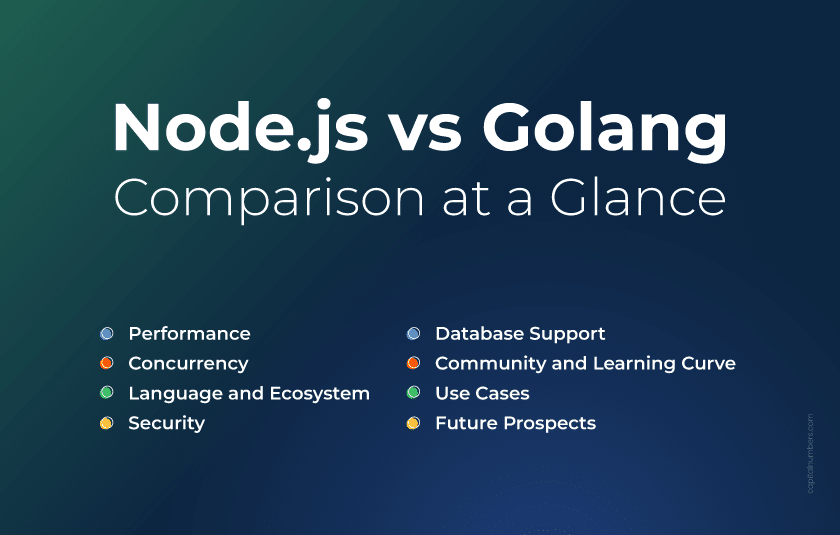Node.js vs Golang: Which Is the Better Choice for Your Next Project?
Table of Contents
Starting a new project but unsure which backend technology to choose? You’re not alone – picking the right one can be tricky with so many options available.
So, why does your choice of backend technology matter? It’s not just about making things work – it’s about maximizing efficiency. From development speed and performance to long-term maintenance and scalability, the right technology can significantly impact the success of your project.
In this blog, we’ll compare two of the most popular backend technologies: Node.js and Golang. We’ll break down their key features and advantages to help you decide which one is the best fit for your next project. Let’s get started!
The Contenders: Node.js vs Golang
Before we compare Node.js and Golang, let’s know about these backend languages:
Node.js: The JavaScript Everywhere Champion
- What it is: Node.js is a runtime environment for running JavaScript code outside of a web browser, making it perfect for building server-side applications. Built on Chrome’s V8 JavaScript engine, it offers exceptional speed and performance.
- Node.js Benefits: Node.js uses event-driven, non-blocking I/O, allowing it to handle multiple tasks simultaneously without delays. Think of it like a super-efficient waiter handling many orders at once without getting stuck. This makes Node.js’s performance excellent for I/O-heavy tasks.
- Scalability: Handles numerous concurrent connections efficiently.
- Unified Language: Allows developers to use JavaScript for both frontend and backend, streamlining development.
- Rich Ecosystem: Access to a massive collection of open-source packages via npm.
Golang (Go): Google’s Lean, Mean Machine
- What it is: Golang is a programming language created by Google, designed for simplicity, speed, and handling many tasks at once. It is a compiled language, meaning it translates directly into highly efficient machine code.
- Benefits: Golang is built-in concurrency with “goroutines.” Imagine tiny, super-fast workers that can all do their jobs simultaneously without getting in each other’s way. This makes Go ideal for highly concurrent systems.
- Performance: Golang delivers superior raw speed for CPU-intensive tasks due to compilation to machine code.
- Simplicity: Features a minimalistic syntax that is easy to learn and read, reducing complexity.
- Memory Efficiency: Goroutines are lightweight, consuming fewer resources than traditional threads.
Looking to Build Scalable, High-Performance Applications?
Hire expert Node.js developers from Capital Numbers today. Our team specializes in creating real-time systems, robust APIs, microservices, and other scalable solutions. To discuss your project, contact us today.
Node.js vs Golang: What are the Differences

Node.js and Golang are powerful frameworks with their strengths and weaknesses. They excel in different areas. Let’s discuss the differences between Go and Node.js in detail:
Performance:
-
Node.js:
Node.js is built for tasks that involve a lot of waiting, such as database queries, external API calls, or file system operations. Its non-blocking I/O and asynchronous nature allow it to handle many concurrent requests efficiently without delays. For example, in an e-commerce site, Node.js can process multiple orders simultaneously, ensuring fast responses even during peak traffic. It’s ideal for apps that need to handle a lot of activity at the same time. -
Golang:
Golang excels in performance for CPU-intensive tasks like complex calculations, data processing, or scientific simulations. As a compiled language, Go directly translates into efficient machine code, giving it a clear edge in raw computational power. This makes Go a top choice for high-performance applications requiring maximum processing throughput.
You May Also Read: Optimizing Node.js Performance: A Comprehensive Guide to Building Faster Applications
Concurrency:
-
Node.js:
Node.js handles concurrency via its event loop, which processes I/O operations asynchronously. This makes Node.js ideal for real-time applications where quick, concurrent responses are key. While a single long-running, CPU-heavy task can impact performance, modern Node.js mitigates this with Worker Threads. It allows developers to offload intensive tasks without blocking the main event loop. This gives it more flexibility in handling diverse workloads. -
Golang:
Go’s goroutines allow it to handle thousands, or even millions, of simultaneous operations with minimal overhead. These lightweight functions, managed by the Go runtime rather than the OS, are a core feature for building high-concurrency systems. Combined with channels for safe communication, they make Go perfect for applications requiring massive scalability and concurrency.
Language and Ecosystem:
-
Node.js:
The Node.js ecosystem is incredibly vast, driven by npm (Node Package Manager). npm hosts millions of open-source packages, providing pre-built solutions that enhance development. This large collection of tools makes it easier to add new features. The “JavaScript everywhere” paradigm also helps teams become proficient in a unified stack. -
Golang:
The Go language champions simplicity and a powerful, concise standard library. Unlike Node.js, Go’s ecosystem is more curated, focusing on built-in functionalities. This often leads to smaller binary sizes and fewer external dependencies, enhancing security and simplifying deployment. Go’s strong static typing and explicit error handling are an advantage for critical systems, making it a strong contender in the Go vs Node.js debate.
Security:
-
Node.js:
Node.js benefits from a large, active community that continually monitors and patches vulnerabilities. Its vast npm ecosystem offers many security-focused libraries (e.g., Helmet, bcrypt). However, this reliance on third-party packages means developers must be careful. Best practices include using dependency scanning tools like npm audit or Snyk, and regularly updating dependencies to prevent common web exploits like injection attacks or inadequate data validation. -
Golang:
Go’s strong static typing and inherent simplicity reduce the likelihood of certain bugs that can cause vulnerabilities, such as type-related errors. Its compiled nature provides a more predictable and isolated runtime, making exploitation harder. Go’s concurrency support helps in securely managing multi-threaded applications by delivering safe, built-in communication via channels, which helps prevent common concurrency bugs like race conditions. The Go community generally follows a security-first approach, making it a solid choice for building secure, high-performance systems.
Enhancing Customer Experience in an AI-powered App with Node.js
The client’s AI-powered messaging app was experiencing issues such as fragmented communication, operational inefficiencies, and more.
Learn how we used Node.js along with other technologies to streamline communication and enhance customer interactions. [Read the case study here!]
Database Support
-
Node.js:
Node.js supports a wide range of databases, both relational (like PostgreSQL and MySQL) and NoSQL (like MongoDB). Its non-blocking I/O model allows for efficient database interactions, especially in real-time applications. Popular libraries like Sequelize and Mongoose make it easy to integrate with databases, ensuring high performance even with multiple concurrent database requests. -
Golang:
Go also offers robust support for relational databases (MySQL, PostgreSQL) and NoSQL databases (MongoDB). While Go’s database ecosystem isn’t as vast as Node.js’s, its simplicity allows for easy integration and custom solutions. Go’s concurrency model and high performance make it ideal for handling large-scale, data-intensive applications.
You May Also Read: MongoDB and Node.js: How Are They Changing the Future of App Development?
Community and Learning Curve
-
Node.js:
Node.js has a large, active community with various resources, tutorials, and third-party libraries. Since it’s built on JavaScript, many developers already know the language, making it easier to learn and get started. The huge ecosystem and support from platforms like Stack Overflow and GitHub make it easier to solve problems and get help when needed. -
Golang:
Go’s community may be smaller, but it is growing fast, with strong backing from Google. It has a simple syntax and minimal design, making it easier to pick up compared to other statically typed languages. However, if you’re new to statically typed languages, it may take a little time to get used to. Also, Go’s unique approach to explicit error handling and its built-in concurrency model requires a different way of thinking that can be a new challenge for developers coming from languages like JavaScript.
Use Cases
-
Node.js Use Cases:
Node.js is perfect for complex solutions that require fast, scalable performance, especially those with high concurrency and I/O-bound operations.
- Real-time Applications: Node.js is a top choice for real-time applications such as chat apps, messaging systems, and live dashboards, where quick data exchange is essential.
- APIs and Microservices: Node.js is a great choice for building RESTful APIs and microservices. Its lightweight nature and ability to handle many concurrent requests make it ideal for microservices integration, where different services can seamlessly communicate with each other. This enables efficient scaling and the ability to maintain modular systems.
- Single Page Applications (SPAs): Node.js integrates well with front-end technologies to handle server-side logic in single-page applications, providing a smooth user experience.
- Streaming Applications: Thanks to its non-blocking I/O, Node.js is ideal for video and audio streaming apps, ensuring continuous data delivery without delays.
-
Golang Use Cases:
Go excels in scenarios that require performance, concurrency, and scalability, making it a great choice for backend-heavy applications.
- Microservices and Cloud-native Applications: Go is highly suited for building scalable microservices and cloud-based solutions, particularly in high-performance environments like Kubernetes.
- High-concurrency Systems: Go’s goroutines and efficient threading model make it perfect for building systems that need to handle thousands or millions of concurrent tasks, like real-time data processing or large-scale web crawlers.
- Networking Applications: Go’s simplicity and performance make it ideal for networking applications, including load balancers and proxies, where speed is critical.
- Command-Line Tools: Go is frequently used to build command-line tools due to its simplicity and fast compilation, making deployment efficient and easy.
Future Prospects
-
Node.js:
- Continued Evolution: Node.js keeps getting better with new releases, like Node.js 24. These bring performance boosts, better developer tools, and new features such as native WebSocket clients, improved TypeScript support (for erasable syntax), and clearer resource management.
- WebAssembly Integration: Deeper integration with WebAssembly (WASM) will let Node.js handle heavy CPU tasks more efficiently by offloading them to WASM modules.
- Serverless and Edge Computing: Node.js is well-suited for growth in serverless environments (like AWS Lambda) and edge computing for its lightweight design and quick startup times.
-
Golang:
- AI and Machine Learning: Go is gaining ground in AI/ML for deploying models and handling large datasets, thanks to its performance and concurrency.
- Cloud-Native Dominance: Go will continue to be a top language for cloud-native development, especially as Kubernetes and microservices grow.
- Tooling and Developer Experience: Ongoing improvements to tools, generics, and error handling aim to make developers even more productive and code easier to maintain.
- WebAssembly (WASM): Further advancements in Go’s WebAssembly compatibility will open up more possibilities for high-performance client-side apps.
Node.js vs Golang: Comparison at a Glance
| Feature | Node.js | Golang |
|---|---|---|
| Language Type | JavaScript (Dynamic Typing) | Go (Static Typing) |
| Concurrency | Event-driven, non-blocking I/O | Goroutines for lightweight concurrent execution |
| Performance | Great for I/O-bound tasks | Excellent for CPU-bound tasks and high throughput |
| Ease of Learning | Easy for JavaScript developers | Moderate, simple syntax but may take time for statically-typed beginners |
| Scalability | Ideal for real-time apps and microservices | Ideal for large-scale distributed systems and microservices |
| Ecosystem | Extensive with millions of npm packages | Smaller, but growing with a focus on performance |
| Community Support | Large, active community (24M+ developers) | Growing community with strong backing from Google |
| Use Cases | Real-time apps, APIs, microservices | High-performance systems, cloud-native apps, networking |
| Development Speed | Fast development due to JavaScript ecosystem | Slower, but optimized for clean, maintainable code |
| Learning Curve | Low (if familiar with JavaScript) | Moderate (due to static typing) |
| Deployment | Easy to deploy on cloud services and platforms | Ideal for containerized and cloud-native environments |
| Future Prospects | Strong growth, especially in real-time and serverless applications | Strong, especially in cloud-native and high-performance systems |
You May Also Read: PHP vs Node.js: Which is Better for Web Development in 2025?
Bottom Line
Which one is right for you: Node.js or Golang? If you need real-time features, fast development, or extensive APIs, Node.js is a great fit. It’s perfect if your team knows JavaScript. Also, its huge ecosystem speeds up progress.
But what if you need raw speed, high concurrency, or system-level performance? That’s where Golang shines. It’s ideal for microservices, cloud solutions, and handling large data. So, think about your project’s needs, your team’s strengths, and what matters most: speed or flexibility, and make the decision.
Why Choose Capital Numbers for Node.js Development?
At Capital Numbers, we specialize in custom Node.js development and integration services. Our team creates scalable applications, from real-time systems to APIs, handling high traffic and complex tasks to keep your business efficient and responsive.
- Expertise You Can Trust: Our developers have years of experience building various Node.js applications, including real-time systems, APIs, and scalable web platforms across multiple industries.
- End-to-End Solutions: We handle everything – from the initial discovery phase to design, development, testing, and ongoing support after launch.
- Tailored to Your Business: Your needs are unique. We build custom Node.js solutions. They fit your exact business goals.
- Dedicated Post-Launch Support: Our commitment continues after launch. We provide ongoing support. Your applications will always run smoothly.
Ready to build something great with Node.js? Schedule a free consultation today!

















